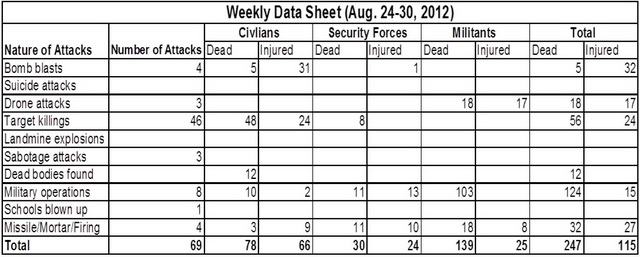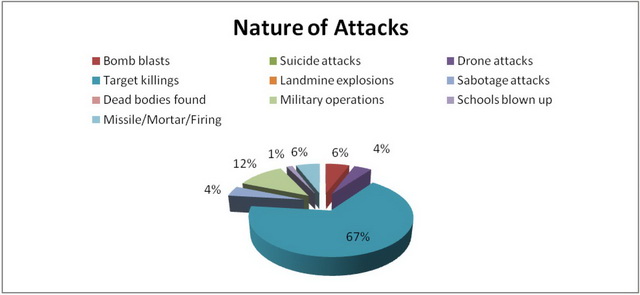The persistent wave of violence swelled significantly across Pakistan during the current week. The cross-border attacks by the Afghanistan-based militants on security check posts in the Salarzai area of Bajaur Agency and the subsequent clashes between military and militants, ongoing military operation in Khyber Pakhtunkhwa (KP) and Federally Administered Tribal Areas (FATA) and the unrelenting wave of target killings in Karachi (Sindh)— rocked Pakistan during the week. The data collected (throughten newspapers that CRSS uses as the source) suggests that as many as 247 persons perished as a result of 69 incidents of violence across the country during the reported week (for detailssee data sheet).These violent incidents also left 115 people injured across the country.
During the current week, militants bore the major brunt of violence—, wherein 56 percent of the total casualties were of the militants. Numerically speaking 139 militants were dead as a result of violent clashes across Pakistan. The second highest number of deaths was ofcivilians, wherein 78 civilians got killed and 66 others wounded under different circumstances. Furthermore, three CIA operated drone strikeswere recorded during the course of the week, killing 18 suspected militants and injuring another 17 in different areas of Shawal valley, North Waziristan Agency (FATA). Militants also blew up an under construction government girls– school in Swabi district (KP).
Moreover sectarian violence continued unabated across the country as three sectarian attacks left five Shia men dead and another two injured in Quetta (Balochistan) and Karachi (Sindh). Moreover, deaths due to the deadly wave of target killings dropped by 16 percent, (22 percent against last week 38 percent) during the current week. Overall, 67 percent of the total violent attacks wereoftarget killingin nature.The trend also underlines that the target killing adamantly remains the weapon of choice in the hands of miscreants to inflict violence (seethe pie chart below).
Furthermore, data shows that of the total 46 incidents of target killings, a staggering 69 percent took place in Karachi alone, leaving 37 people (77 percent of the total dead in target killings) dead. Deaths of militants in the ongoing military operations in KP and FATA region surged by 22 percent, as militant casualties due to military operation accounted for 41 percent of the total loss of lives against last week 19 percent. Meanwhile, 30 security personnel lost their lives and 24 others got injured as a result of clashes with the militants during the week.
Furthermore, 12 dead bodies were also recovered from different areas of KP, Balochistan and Sindh provinces, eight of the total dead bodies were found in Karachi alone. In sum, the number of violent incidents increased considerably from last week 38 to 69 during this week, also the resultant fatalities spiked sharply from 121 to 247 during the current week. While the number of wounded swelled from 83 to 115 this week.
A succinct peep into the data and trends of violence underlines the fact that the scale and frequency of violence is getting worse in recent weeks across Pakistan. Security challenges, both at internal and external fronts are battering the prospects of peaceful settlement of local conflicts, meanwhile pushing the adversaries towards the adoption of extremely violent means of violence. Almost all sources of violence, like sectarian, religio-terrorism, ethno-political, criminal, etc., which historically plagued the security landscape in Pakistan, are playing out simultaneously these days. And as a result badly taxing all the parties involved in the violence. Against this backdrop, we see that, surprisingly, the role of political leadership is almost missing in the unfolding security situation in the country. Right wing political parties like Pakistan Muslim League-Nawaz, Pakistan Tehrik-i-Insaf, Jamat-i-Islami, Jamiat Ulema Islam, etc., are consciously silent. While left leaning and so called liberal political parties like Pakistan Peoples– Party, Awami National Party and Muthida Qaumi Movement seem unwilling to condemn and curtail militancy out of political pragmatism (due to impending elections).
Sources
- The News
- Dawn
- The Express Tribune
- Pakistan Today
- Daily Times
- The Frontier Post
- Jang (Urdu)
- Daily Mashriq (Urdu)
- Aaj (Urdu)
- The Nation


